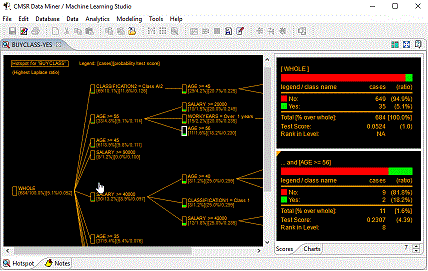Hotspot
Profiling and Top-down Drill-down Analysis
|
Hotspot analysis drills-downs data systematically and
detects important relationships, co-factors, interactions, dependencies
and associations amongst many variables and values accurately,
and generate profiles of most interesting segments.
Hotspot analysis is very easy to use and provides analytic power un-paralleled
by other statistical and OLAP tools.
|
Hotspot Analysis performs the followings at the same time using Artificial Intelligence Technology;
- Segmentation: Divide populations into segments.
- Profiling: Develop profiles of hotspot segments.
- Drill-down: Automatically drill-down dimensions and numerical value ranges.
- Variable selection: Automatically select variables used in profiling and segmentation.
- Ranking: Order segments based ranking criteria.
- Visualization: Visualize result statistics.

This is a hotspot module screenshot. It consists of the following components;
- Left is a drill down map of hotspots.
- Top right figures show details of the whole population.
- Bottom right figures show details of a selected hotspot node.
Application Cases
The following example cases can best explain where hotspot analysis can be used;
- A telecom company wish to find out profiles of customers who are defecting
to rival providers.
For more, read
customer retention.
- An insurance company wishes to find out all the most (or least) important factors of policy claims.
For details on insurance risk analysis, click here.
- A bank wishes to find out all the most (or least) important factors
on loan defaults.
For details on default risk analysis, click here.
- A department store wishes to find out demographic and geographic profiles of
customer groups that responded best in the previous
catalog mailing campaigns
and wish to use the information to boost overall sales.
- A utility provider wishes to find out profiles of customers who defected to
rival providers and use it to develop customer retention strategies.
- A healthcare fund wants to know profiles of fraudulent healthcare claims and providers
(fraud detection).
- A market research firm wants to identify all the most and least
important factors (or demographic properties) of certain product sales.
- A census bureau wishes to identify demographic groups that have most even incomes,
using harmonic means, from its census data.
- An institutional equity investment firm wishes to find out
important factors in relation to share market performance, dividends, bankruptcies, etc.
- A clinical research firm wishes to identify factors that have most drastic
effects on occurrences of certain diseases, or wishes to find out factors that lead to
effective treatment or side effects of drugs and/or treatments, out of hundreds of
variables observed.
- A political pollster wants to know major demographic profiles that give
propensity to a particular political party or candidate.
Application areas
Hotspot is very effective for dimensional data analysis. You can use hotspot
as replacement of primitive OLAP & BI tools and get surprising results;
Top-down Drill-down Data Analysis
|
Traditional techniques with statistical or OLAP packages can be considered as
bottom-up approaches. In the approaches, fields and their values are
examined one by one manually. This is a time consuming and error-prone process.
Furthermore, if data contain many fields with complex domain structures,
the process simply becomes an impractical task!
|
Hotspot analysis, on the other hand, employs top-down analytic process using
using Artificial Intelligence techniques. Analysis starts from the whole
population. Step-by-step, it generates hypothesis in all possible directions,
tests (or scores) them with the input data, and order them.
This provides analysts accurate mapping of most interesting segments, i.e., hotspots.
Analysts also perform tasks in a top-down fashion. Initially,
hotspot search can be used to identify factors, properties, sub-populations, etc.
It offers starting points for top-down data analysis. When hotspots are identified,
the following tools can be used to further the analysis;
- Visualization: 3D, Bar, Pie, Area, Boxplot, Histogram, Scatter plot, Normal Quartile Plot, ...
- Cross tables and hotspot analysis.
- Parametric and non-parametric statistics.
- Statistical test procedures.
For software,
please find downloads from Data Mining Software.
|
|

